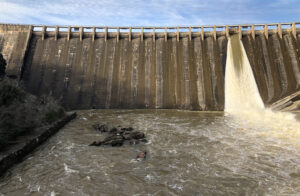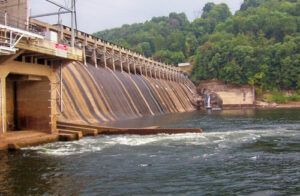Eagle Creek Renewable Energy owns and operates 86 hydroelectric projects across the United States, representing about 620 megawatts (MW) of power capacity. A wholly owned subsidiary of Ontario Power Generation (OPG), Eagle Creek recently merged with Cube Hydro Partners, expanding its portfolio and its capacities. In this interview, Dusty Myers, Eagle Creek’s chief dam safety engineer, tells us about the company’s hydro assets, his team’s work, and the regulatory trends that are shaping the dam safety field.
Hydro Leader: Please tell us about your background and how you came to be in your current position.
Dusty Myers: My career in dam safety has included stints as a regulator at the state level; at a federal dam owner; and now at a private dam owner, Eagle Creek. I graduated from Mississippi State University in December 2004 with a bachelor’s degree in civil engineering and received a master’s degree in environmental engineering from Jackson State University in 2010. After graduating from Mississippi State, I accepted a position with the Mississippi Department of Environmental Quality (MDEQ), performing surface water quality modeling for impaired water bodies within the state. In November 2007, I transitioned into dam safety by accepting a position with the dam safety division of MDEQ as a staff dam safety engineer. When I started with MDEQ dam safety, the program was responsible for the regulation of approximately 3,800 dams around the state of Mississippi. As time progressed, I began to get more involved in the dam safety community through the Association of State Dam Safety Officials (ASDSO), first as a member of the newly formed dam failures and incidents committee in 2010 and then as a southeast regional representative to the ASDSO board of directors in 2011. I served on the ASDSO board of directors from 2011 to 2019 and was president of the association from 2016 to 2017. Throughout my time on the board, I was highly involved in a lot of other ongoing work with the association and served as a member or chair in nine task groups or committees. I continue to be involved with ASDSO as a member of the dam failures and incidents committee, the model dam safety program task force, and the advisory committee.

In February 2014, I was selected as the chief of the MDEQ dam safety division. A couple of the major initiatives of the program during my tenure as the chief of the division were the reinventory of dams in the state, which increased the inventory of dams to more than 6,500, and participation in a regional probable maximum precipitation study for Arkansas, Louisiana, Mississippi, and Oklahoma. In May 2019, I decided to accept a position as senior specialist in dam safety policy with the Tennessee Valley Authority (TVA) in Chattanooga, Tennessee. My focus during my tenure at TVA was on dam safety protocols and oversight of the TVA dam safety independent review board.
After a few months at TVA, I received a call about an opening for the chief dam safety engineer position at Eagle Creek Renewable Energy and decided to join Eagle Creek in November 2019. In summer 2020, I relocated to Oak Ridge, North Carolina, so that I would be closer to the Eagle Creek Office in Badin, North Carolina.
Hydro Leader: Please tell us about Eagle Creek as a company.
Dusty Myers: Eagle Creek traces its earliest roots to 1978, when the North American Hydro Company began operations in the upper Midwest, acquiring small, nonoperating, or underperforming plants and rehabilitating them to increase power production and reliability, eventually creating a portfolio of well-performing hydroelectric power facilities. Eagle Creek was founded by initial investor Hudson Clean Energy Partners in 2010 to acquire, enhance, and operate the Mongaup River Hydroelectric System in New York. It subsequently acquired North American Hydro in 2012, benefiting from the expertise of the staff there.
Later in 2012, Eagle Creek acquired the development rights to the Ball Mountain and Townshend projects in Vermont and began work to construct those facilities. In 2013, with additional financing from investors led by Power Energy Corporation, a subsidiary of Power Corporation of Canada, Eagle Creek acquired 10 small hydroelectric facilities in the Northeast and began work to rehabilitate and enhance them. Since 2013, Eagle Creek has grown through the acquisition of operating, partially operating, and nonoperating facilities and has rehabilitated and improved more than 25 hydroelectric turbines that were previously out of service.
Meanwhile, Cube Hydro was formed in 2014 when Enduring Hydro entered into a partnership with I Squared Capital Infrastructure Fund to pursue the development and acquisition of hydroelectric power plants in North America. Enduring Hydro was originally founded in 2011 by Dr. Kristina M. Johnson, former under secretary of energy for the U.S. Department of Energy. In 2012 and 2013, the Enduring Hydro team successfully completed the permitting and construction of the 6 MW Mahoning Creek Hydroelectric Plant on an existing U.S. Army Corps of Engineers dam located in Kittanning, Pennsylvania. This was the first hydroelectric power plant built in Pennsylvania in over 25 years. After 2014, Cube Hydro grew rapidly through acquisitions.
In November 2018, OPG acquired Eagle Creek from Hudson Clean Energy Partners, Power Energy Corporation, and its other previous investors. On October 8, 2019, OPG announced the finalization of the acquisition of Cube Hydro Partners and Helix Partners (collectively, Cube Hydro) from I Squared Capital. The two companies are now merged and operating under the Eagle Creek name. Eagle Creek continues to seek opportunities to acquire small hydroelectric facilities and improve them to increase clean power production, operate them in harmony with the environment around them, and enhance the value of the company’s hydroelectric portfolio for its investor, employees, host communities, and all stakeholders in the projects.
Hydro Leader: Who does Eagle Creek sell its energy to?
Dusty Myers: We sell our power to regional power markets or specified offtakers through power purchase agreements.
Hydro Leader: What is the average age of your facilities?
Dusty Myers: The projects Eagle Creek owns or operates were constructed from the late 1800s to as late as 2013, with a large number constructed in the early 1900s. Thus, a large number of our facilities are around 100 years old.
Hydro Leader: How will Cube Hydro Partners’ assets benefit Eagle Creek?
Dusty Myers: The merger of Cube Hydro and Eagle Creek, both of which were small hydropower companies, has created a unique opportunity to strengthen internal expertise and improve in-house resources. A couple of specific changes that have been made involve building out a more robust in-house mechanical and electrical
engineering team as well as a more robust dam safety team. Cube Hydro previously had an in-house engineering team, but Eagle Creek did not. As mentioned, the increased size of the company also allowed us to hire a dam safety team whose sole focus is on dam and public safety.
Hydro Leader: Are you the person who has been in charge of the growth of the dam safety team?
Dusty Myers: The short answer is yes. I was hired by Eagle Creek in November 2019, shortly after OPG acquired Cube Hydro. From November 2019 until mid- 2020, my team was focused on the 65 projects that were in the legacy Eagle Creek portfolio. The legacy Cube dam safety program continued to be managed by other existing staff until mid-2020, when all dam and public safety responsibilities were integrated under one team. In September 2020, we filed a revised Owners Dam Safety Program with the Federal Energy Regulatory Commission (FERC), fully integrating the dam and public safety programs of the two legacy companies.
Hydro Leader: What are the primary areas of your responsibility as chief dam safety engineer, and what are the primary safety risks that you work to mitigate?
Dusty Myers: My primary responsibility as chief dam safety engineer is to ensure that our dams are operated and maintained in a safe and reliable manner in order to protect downstream lives and property. The risk-mitigating projects that we are generally focused on deal with the typical things you would expect to see at older hydropower projects, such as deteriorated concrete, painting old gates, and upgrading mechanical and electrical systems.
We also have a number of ongoing engineering studies at our projects to reevaluate stability and spillway capacity. Some of these studies have resulted in modifications to our projects but most only result in an improved understanding of our dams.
Hydro Leader: Are all your dams regulated by FERC?
Dusty Myers: All our projects, except one small hydropower plant in Wisconsin, are regulated by FERC. A few of our projects are also at dams owned by state or federal governments, where our dam safety responsibilities are minimal.
Hydro Leader: Does your role encompass the issue of public safety around dams?
Dusty Myers: Yes. Public safety is an integral part of the Eagle Creek dam safety program.
Hydro Leader: Given that Eagle Creek is owned by OPG, do you follow the public safety guidelines that OPG has developed?
Dusty Myers: Our team is slowly transitioning and making improvements to our public safety program to better align our program with OPG’s, while still meeting the requirements of the FERC guidelines. Recently, OPG requested that we begin using a classification system it developed for categorizing dam and public safety incidents so that any issues that arise can be reported up consistently to the OPG board. As such, we developed our own policies and procedures to mirror these guidelines as much as possible.
Hydro Leader: Given that some of the dams you own and operate are 100 years old or older, do they require major rehabilitation?
Dusty Myers: A number of significant modifications, including spillway upgrades and modifications and anchor installations, were made at some of our projects in the 1980s, but most work since that time has been primarily maintenance and relatively minor capital investments. However, as dam safety regulations and guidelines continue to evolve and older analyses, such as inflow design flood analysis and stability analysis, continue to be reevaluated, some of our projects may require rehabilitation or more significant upgrades in the future.
Hydro Leader: Are there any other major trends in dam safety that are affecting Eagle Creek?

Dusty Myers: One thing we are tracking closely is the proposed FERC guideline revisions that were published in 2020. These proposed revisions would significantly alter the requirements for the FERC part 12D inspections that are required at our high- and significant-hazard projects. The proposed revisions will incorporate risk analysis in the part 12 process, and as such, we have decided to proactively begin incorporating risk discussions in our part 12 potential failure modes analysis process to better prepare ourselves for this change.
Hydro Leader: What is your vision for the future of the Eagle Creek dam safety program?
Dusty Myers: Our dam safety team and the company as a whole are focused on continuous improvement. For the dam safety program, we are using the maturity matrices developed by the Centre for Energy Advancement through Technological Innovation and its member dam owners. The matrices are a tool that breaks dam safety down into 12 elements (governance, surveillance and monitoring, public safety, flow control equipment, etc.). Through our internal assessments, we identify actions that we can take to improve the dam safety program each year. Our end goal is to have a strong dam safety program that is well aligned with the industry and comparable to those of hydropower owners that have been in the business much longer.
Dusty Myers is the chief dam safety engineer at Eagle Creek Renewable Energy. He can be contacted at dusty.myers@eaglecreekre.com. 

